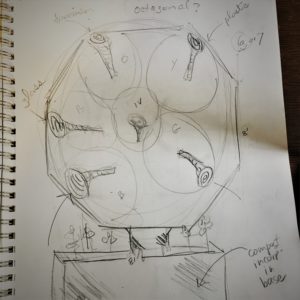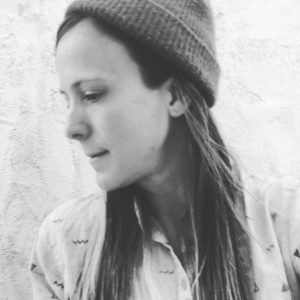When I was younger, maybe by the age of seven or so, I knew our world was vastly different than it had been in the past. Time felt as if it were speeding up, and our hearts were becoming evermore filled with concerns of the health of our precious wet rock cruising through space. The 80’s were no cake-walk for the earth. In fact, it was at that time that humans were really gearing up for the challenges we face today. I knew things were different because my elders spoke of oil spills and eminent future ones, correlations with toxic pollution and increases in cancer rates, and what the inevitable production of mass-produced products made from, and packaged in plastic may be doing to our places and our minds.
We fumble towards meager efforts to reduce our use of it, but oftentimes it seems so unavoidable. We feel defeated, we relinquish our hearts truest feelings for convenience every day, and oftentimes, multiple times a day. Fast-forward to my twenties, I graduated from college in Gunnison, and moved to Aspen for a job. I found that trash was pretty much on every surface of our precious lithosphere. I started an Instagram account about that time, and I was following a group of concerned citizens called @threepieces. Their platform was based on the concept of picking up microtrash wherever you found yourself walking. The very idea impacted me deeply. I continue to feel deep gratitude for acknowledging the ground I walk upon and offering my hands up for the purposes of healing the earth and myself simultaneously. The act of ridding places from the microtrash itself allowed for me to become more aware of a deeper part of being in a particular place, whether known for its beauty or not.
Even in the perceived untouched areas like Aspen, candy wrappers, plastic to-go containers, lipstick applicators, you name it; were bound to be found on the ground. It really hit home when I went to Mexico for a once-in-a-lifetime yoga retreat. It was literally everywhere.
I couldn’t help but think upon that experience, paired with a degree in Environmental Studies, that we had, as a species, created a monster. Earth lacks the ability to decompose plastic for hundreds, if not thousands of years. Moving away from plastic products and plastic-wrapped products is happening but not quickly enough. We didn’t mean to create this unruly leviathan, but we certainly did. Sidewalks, streets, waterways, rivers, gardens, parks and just about anywhere you go are slowly showing signs of more and more microtrash. Just look down.
Going back in time, we can praise the creator of plastic, Leo Baekeland, for his whimsical discovery. Surely it changed our daily lives in many helpful ways. He invented Bakelite in 1907, which was the forerunner to the plastic in our lives today. I am sure people fell deeply in love with its sheen look, durability and color schemes. In particular, people enjoyed its affordability. It was marketed as ‘the material of a thousand uses.’ People found it to be woven into every part of their daily lives by the 50’ and 60’s. And now in 2018, there are an infinite amount of uses. Earth could not brace herself for such a creation. Alas, here she is, asking us for help and there are endless ways to throw yourself at a cause. Gratefully, our community is full of those very souls breaking the silence and facing the growing issues across a broad environmental spectrum.
I had a vision a few years back and I’ve been wanting to share with you, my community and fellow friends. By this point, I was now in my early thirties. I have always held my environmental convictions close to my duties and tried to marry them as often as possible. With the aforementioned degree that I obtained, I couldn’t unknow what I’ve learned about the challenges humans are now facing. Having collected trash in broad daylight, in the darkest of alleys, on jogs, on main streets in towns, and just about anywhere microtrash was present, I began to realize more could be done.
How could the restorative feeling of combing Carbondale be shared? This idea of dissolving the line between a cityscape and a natural landscape became so obvious to me. It is a way to honor all places, all the time. I started ‘hip-swingin’, trash-pickin’ jogging crews. They were, and still are, very fun and packed with lunges, squats, laughs, an audience that finds it fascinating and an abundance of that feel-good buzz emanating from our sweaty pores.
I still wanted to reach more people who would like to collect trash and are very passionate about our place here in the mountains. So one day while hiking, the idea hit me like a plastic water bottle flung by the wind…an interactive art installation was the very thing that could engage more people. I thought that this installation could be in every town, at the base of every trailhead and anywhere it caught on. It would be a fun tool for collecting microtrash!

Sketch, Tracie Wright
I envision it would be made of reclaimed plexiglass, and on its surface would be several channels that gradually decrease in diameter towards the object’s center. Everybody could place microtrash creatively in the installation’s core, filling it with trash that slowly becomes a work of art, albeit the microtrash would be sent to the landfill over and over again, changing color with the changing trash it collected. I wanted to share the joy that I felt when collecting microtrash. The small pieces, the ones that get overlooked, would begin to get deposited into this oracle of play matched with a moral obligation to keep our places clean. It sounds crazy, but it really has brought me joy to clean up the immediate ground I walk upon. Even as you are reading this, can’t you recall how good it feels to tidy and tend to your personal spaces on a regular basis?
Carbondale is my home, as it is for many of you reading this. I realized that towns should be treated as equals to the trails, national forests and pristine spaces. All are sacred. All should be cared for; not just its parts. I found that with every piece I picked up via a lunge, squat, yoga pose, or dance move, I felt closer to, and more in love with, the cityscapes that abutt the beautiful landscapes that are the raison de etre here in Carbondale.
What if that’s just it? What if reconnecting ourselves with our current task of picking up what’s under our feet in town we are more intimately connected to the places we regard as sacred and untouched? What if this concept is the shift needed to create the fervor for having the two become one? What would that future look and feel like— where our living spaces become one with our wild spaces– in such a way that the wild spaces guide us to care for, and reduce our impacts on the bustling places? Would the boat turn? Would the struggle on the ledge we find ourselves dissipate? It is not a light, cosmic task, but it is worth every step and every swoop to earth. And every heart the better for it.
Now we have arrived at the true nature of the sculpture that I envision. It would turn a perceived and easily avoided obligation into play! Numerous studies show that bringing play into what we consider to be work releases endorphins in the brain, and allows for greater and deeper connection to that work and to our place. This act would allow alternative avenues for the human soul to reconnect and reawaken. Our town places would begin to mirror our nature places; they would become one in the sense that we care for equally.
So, that’s my, ‘if I could, what would I?’ I anticipate that these art installations will be all over the world, and every day, I hear of the global community starting to tune into this concept. It’s not just me that has thought of an interactive art display that focuses on cleaning our places. So, you don’t have to be a hip-swingin’, squat-loving person to participate.
If the profound nature of beginning is to reconnect with our places and get rid of the lines that separate the sacred and the city, then we should have more play married to our great work of cleaning up the mess we’ve made.
Did that last sentence hit a nerve? I’m not saying we are literally messy, but we cannot ignore who we’ve become as a collective group. As a teacher, I remind children that what you do has an impact on the whole group and that we are all connected. Children exhibit the ability to lend a hand whenever it is needed because they are learning that their hands have purpose; and a big part of that purpose is helping others when it is needed. Could it be said that we are helping those who throw trash to the ground by modeling good behavior and picking it up? I think so. Children reach out when they know there is no reward. Can we follow the examples of the people of the future?
Do you feel you haven’t been the culprit of the microtrash? I feel the same way. That didn’t stop that feeling I got that I was helping in a big way. Yes, I know there are far bigger environmental tragedies. This one, though, is a psychological one. Remember, our thoughts pave our lives, and our actions make us more connected every day. Let’s make it known that caring for Carbondale is a priority. Let’s become the cleanest, greenest small city the world has ever known!
I understand if you’re reading this and are thinking that you shouldn’t have to clean up after others, or you’re not the one trashing the place— so why should I clean it up? I can tell you, those thoughts will continue to divide us, and as soon as we do the work for the greater good for all that live, we will begin to feel deep in our bones the benefits of doing something… because it is simply the right thing to do.
Is the action of awakening the ground we walk on through kneeling and combing it what we need to turn this ship around? I believe it is a part of the cumulative actions, and we must not falter in those causes. We should all grab a paddle and get steered in the right direction, and Carbondale is a great place to start.

Contributing writer, Tracie Wright
I moved to Colorado at the age of 18. I am now going on 36. Before making the big leap, my Mother and I would travel together in the Summer to the West. While in Wyoming, someone mentioned Crested Butte. A year later, my Mom and I went to Crested Butte. I was forever changed, and could not go back to Texas. I let my Mother drive my car back to Texas, and I never looked back. I earned a Bachelor’s Degree in Environmental Studies at WSCU and moved to Aspen in 2006. I taught snowboarding and worked really hard at a restaurant in downtown Aspen for six years. I fell in love with Aspen Highlands through bootpacking two years in a row. Also forever changed me. I slowly made my way toward Carbondale, working a bit in Woody Creek at the Community Center. I moved to Carbondale in 2012, and fell in love with teaching at Ross Montessori School. I am now in my third year with the incredible support of the families of the children I work with every day, and the administration that help me succeed at my job. I own a strawbale home, I conserve energy and use greywater whenever possible. Oh, and I pick up microtrash.

